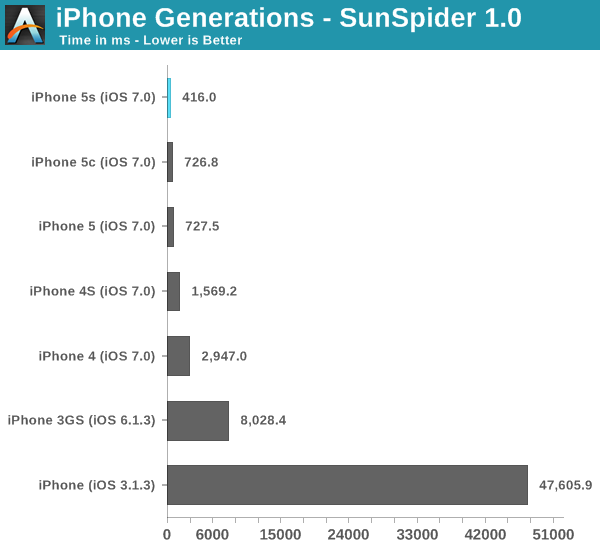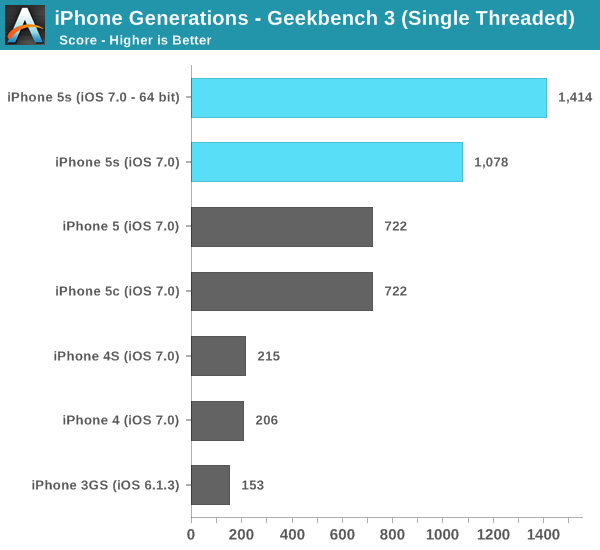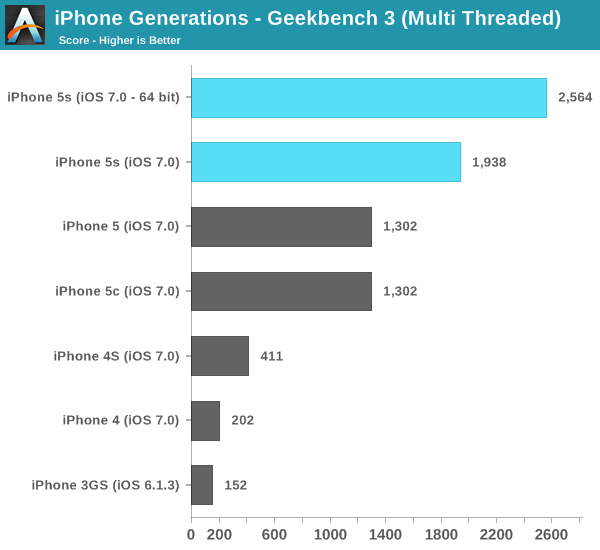The iPhone 5s Review
by Anand Lal Shimpi on September 17, 2013 9:01 PM EST- Posted in
- Smartphones
- Apple
- Mobile
- iPhone
- iPhone 5S
iPhone Performance Across Generations

Performance improved by a factor of 100x compared to the original iPhone. You can cut that in half if the iPhone could run iOS 4. Needless to say, Apple's CPU performance estimates aren't unreasonable. We've come a long way since the days when ARM11 cores were good enough.
Even compared to a relatively modern phone like the iPhone 4, the jump to a 5s is huge. The gap isn't quite at the level of an order of magnitude, but it's quickly approaching it. Using the single core iPhone 4 under iOS 7 just feels incredibly slow. Starting with the 4S things get a lot better, but I'd say the iPhone 4 is at the point now where it's starting to feel too slow even for normal consumers (at least with iOS 7 installed).

Browsermark 2.0 gives us a good indication of less CPU bound performance gains. Here we see over a 5x increase in performance compared to the original iPhone, and an 83% increase compared to the iPhone 4.
I wanted to have a closer look at raw CPU performance so I turned to Geekbench 3. Unfortunately Geekbench 3 won't run on anything older than iOS 6, so the original iPhone bows out of this test.

Single threaded performance scaled by roughly 9x from the 3GS to the iPhone 5s. The improvement since the iPhone 4/4S days is around 6.5x. Single threaded performance often influences snappiness and UI speed/feel, so it's definitely an important vector to scale across.

Take into account multithreaded performance and the increase over the 3GS is even bigger, almost 17x now.
The only 3D test I could get to reliably run across all of the platforms (outside the original iPhone) was Basemark X. Again I had issues getting Basemark X running in offscreen mode on iOS 7 so all of the tests here are run at each device's native resolution. In the case of the 3GS to 4 transition, that means a performance regression as the 3GS had a much lower display resolution to deal with.

Apple has scaled GPU performance pretty much in line with CPU performance over the years. The 5s scores 15x the frame rate of the iPhone 4, at a higher resolution too.
iPhone 5s vs. Bay Trail
I couldn't help but run Intel's current favorite mobile benchmark on the iPhone 5s. WebXPRT by Principled Technologies is a collection of browser based benchmarks that use HTML5 and js to simulate a number of workloads (photo editing, face detection, stocks dashboard and offline notes).

Granted we're comparing across platforms/browsers here, but the 5s as a platform does extremely well in Intel's favorite benchmark. The 5c by comparison performs a lot more like what we'd expect from a smartphone platform. The iPhone 5s is in a league of its own here. While I don't expect performance equalling the Atom Z3770 across the board, the fact that Apple is getting this close (with two fewer cores at that) is a testament to the work done in Cupertino.
At its launch event Apple claimed the A7 offered desktop class CPU performance. If it really is performance competitive with Bay Trail, I think that statement is a fair one to make. We're not talking about Haswell or even Ivy Bridge levels of desktop performance, but rather something close to mobile Core 2 Duo class. I've broken down the subtests in the table below:
| WebXPRT Performance (time in ms, lower is better) | ||||||
| Chrome/Mobile Safari | Photo Effects | Face Detection | Stocks | Offline Notes | ||
| Apple iPhone 5s (Apple A7 1.3GHz) | 878.9 ms | 1831.4 ms | 436.1 ms | 604.6 ms | ||
| Intel Bay Trail FFRD (Atom Z3770 1.46GHz) | 693.5 ms | 1557.0 ms | 542.9 ms | 737.3 ms | ||
| AMD A4-5000 (1.5GHz) | 411.2 ms | 2349.5 ms | 719.1 ms | 880.7 ms | ||
| Apple iPhone 5c (Apple A6 1.3GHz) | 1987.6 ms | 4119.6 ms | 763.6 ms | 1747.6 ms | ||
It's not a clean sweep for the iPhone 5s, but keep in mind that we are comparing to the best AMD and Intel have to offer in this space. I suspect part of why this is close is because both of those companies have been holding back a bit (there's no rush to build the fastest low margin parts), but it doesn't change reality.










464 Comments
View All Comments
ddriver - Wednesday, September 18, 2013 - link
My basis for this conclusion is how the article is structured, the carefully picking of benchmarks and selective comparisons. This is clearly visible and has nothing to do with the actual chip specifications. It has nothing to do with execution mode specific details. So no, I don't have problem with facts, unlike you.Furthermore, that 30% number you were focused on is hardly impressive and proportional to the claims this article is making. In a workload that would take an hour, 30% is a noticeable improvement, but for typical phone applications this is not the case.
Dooderoo - Wednesday, September 18, 2013 - link
The structure of the article and the benchmarks are mostly the same as they use in most reviews, excluding some Android specific benchmarks. Where exactly do you see "carefully picking of benchmarks and selective comparisons". Put differently: what benchmarks should they include to convince you there is no "cunning deceit" at work?What claims in the article are not proportional with the 30% (actually more) performance gain?
I won't even comment on the "not a noticeable improvement" bit.
andrewaggb - Wednesday, September 18, 2013 - link
My issue with all the benchmarks is that they are mostly synthetic. The most meaningful benchmarks are the applications you plan to use and the usage patterns you are targeting. Synthetics are fascinating, but I think it's generally a mistake to buy anything based on them.notddriver - Thursday, September 19, 2013 - link
Um, so if a 30% improvement is hardly impressive and irrelevant to phones, then isn't the entire concept of reviewing phones on the basis of hardware performance also irrelevant? Which would make your complaints about the biased-yet-insignificant-review as vital as a debate over whether Harry Potter or Spiderman would be better at defending Metropolis.Incidentally, my iPhone 5 is powerful enough that I never notice any issues—as I'm sure the last generation of Android phones would be. But if your going to go to town over a dozen or more comments about a topic, at least pretend that it matters a tiny bit. Just good form.
oRdchaos - Wednesday, September 18, 2013 - link
I've seen people all over the web get very worked up about people's phrasing with regard to 64-bit. Would you prefer the title of the section were "Performance gains from a 64-bit architecture and the new ARMv8 instruction set"? People keep arguing that 64-bit in a vacuum doesn't give much performance gain. But there is no vacuum.I think the article is very clear to point out where gains are from additional instructions, versus a doubling of the register bit width, versus improved memory subsystem/cache. I'm sure when they get chances to write more of their own tests, they'll be able to pinpoint things further.
sfaerew - Wednesday, September 18, 2013 - link
engadget is multi-thread geekbench performance. tegra4 4cores vs A7 2coresSpoony - Wednesday, September 18, 2013 - link
- You are correct, there are no native cross-platform benches used. Which ones do you suggest Anandtech use? We all know Geekbench is essentially meaningless across platforms.- If you are talking about this engadget review: http://www.engadget.com/2013/09/17/iphone-5s-revie... It appears that Nvidia SHIELD (Tegra 4) led in only one benchmark out of six. This makes your statement incorrect. LG G2 is more competitive. Need we repeat how inaccurate Geekbench is cross-platform. It is as apples-to-oranges as the JS tests.
- I believe what Anandtech was attempting to show with the encryption was the difference ARMv8 ISA makes. In fact the title of that somewhat sensational chart is "AArch64 vs. AArch32 Performance Comparison". So while you are right, the encryption tests are handled in a fundamentally different way, that way is part of the ISA and is an advantage of AArch64, and thus is valid in the chart.
- It will be curious to see whether Qualcomm can deliver A7 like performance using ARMv7 with extended features. My position is no, which is the whole point of that entire page of the review. ARMv8 is actually enabling some additional performance due to ISA efficiency and more features.
- I think noticeable memory footprint bloat of a 64-bit executable is completely ridiculous. But to see if I was right, I did some testing. It's getting a bit hard to find fat binaries to take apart these days, most things are x86_64 only. But I found a few. I computed for three separate applications, took the average, and it looks like about a 9% increase in executable size. Considering that executables themselves are a tiny part of any application's assets, I think it is completely insubstantial. If you calculate the increase in executable size versus the size of the whole application package, it averages to a less than 1% increase.
I too am a bit sad that Apple didn't increase the RAM, and also equally sad that connectivity was left out this rev. I continue to be sad that there is not a more serious storage controller inside the phone. You make some valid points, but I think you also make some erroneous ones. The question with phone SoCs is: Is this a well balanced platform along the axes of performance (GPU and CPU), power consumption (thus heat), and features. I believe that the A7 is well calibrated. Obviously Qualcomm is also doing great work, and perhaps their SoCs are equally as well calibrated.
ddriver - Wednesday, September 18, 2013 - link
- This is entirely his decision, considering writing those reviews is his job, not mine. He can either use actual native benchmarks which reflect the performance of the actual hardware, or call it JS VM performance instead of CPU performance, because different JS implementations across platforms are entirely meaningless.- there is only one geekbench test at engadged. That is what I said "geekbench" - I did not imply it was faster in all tests in the engadged review, I don't know why you insinuate I did so. IIRC snapdragon 800 is actually a little slower in the CPU department than tegra 4, and only faster in the graphics department.
- the boost in encryption is completely disproportional to other improvements and is due to hardware implementations, not 64bit execution mode. So, if anything, it should be a graph or chart on its own, instead of using it to bulk up the chart that is supposed to be indicative of integer performance improvements in 64bit mode.
- maybe v7 chips with 128 bit SIMD units will not deliver quite the performance of A7, because there is more to the subject than the width of the registers (the number of registers doesn't really matter that much), like supported instructions. At any rate, v7 chips are still quad core, which means 4x128bit SIMD units compared to the 2 on A7, albeit with a few extra supported instructions. Until any native benchmark that guarantees saturation of SIMD units pops out, it will be a foolish thing to make a concrete statement on the subject. But boosting v7 SIMD units to 128bit width will at least make it competitive in number crunching scenarios, which use SIMD 99% of the time.
- this is very relative, you can store the same data in three different containers and get a completely different footprint - a vector will only use a single pointer, since it is continuous in memory, a forward list will use a pointer for every data element, a linked list will use two. Depending on the requirements, you may need faster arbitrary inserts and deletions, which will require a linked list, and in the case of a single byte datatype, a 32bit single element will be 12 bytes because of padding and alignment, while in 64bit mode the size will grow to 24 bytes, which is exactly double. Granted, this is the other extremity of the "less than 1%" you came up with, truth is results will vary in between depending on the workload.
As I said in the first post, the wise thing would be to reserve judgement until mass availability, mostly because I know corporate practices involving exclusive reviews prior to availability, which are a pronounced determining factor to the initial rate of sales. In short, apple is in the position to be greatly rewarded for imposing some cheating requirements on early exclusive reviewers. And at least in this aspect I think everyone will disagree, apple is not the kind of company to let such an opportunity go to waste.
ddriver - Wednesday, September 18, 2013 - link
*no one will disagreeDug - Wednesday, September 18, 2013 - link
I will."As I said in the first post, the wise thing would be to reserve judgement until mass availability, mostly because I know corporate practices involving exclusive reviews prior to availability, which are a pronounced determining factor to the initial rate of sales. In short, apple is in the position to be greatly rewarded for imposing some cheating requirements on early exclusive reviewers. And at least in this aspect I think everyone will disagree, apple is not the kind of company to let such an opportunity go to waste."
Prove it and stop making assumptions.